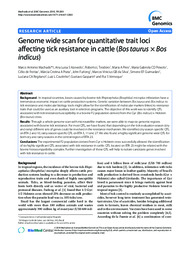Genome wide scan for quantitative trait loci affecting tick resistance in cattle (Bos taurus x Bos indicus).
Genome wide scan for quantitative trait loci affecting tick resistance in cattle (Bos taurus x Bos indicus).
Author(s): MACHADO, M. A.; AZEVEDO, A. L. S.; TEODORO, R. L.; PIRES, M. de F. A.; PEIXOTO, M. G. C. D.; FREITAS, C. de; PRATA, M. C. de A.; FURLONG, J.; SILVA, M. V. G. B.; GUIMARÃES, S. E. F.; REGITANO, L. C. de A.; COUTINHO, L. L.; GASPARIN, G.; VERNEQUE, R. da S.
Summary: Background : In tropical countries, losses caused by bovine tick Rhipicephalus (Boophilus) microplus infestation have a tremendous economic impact on cattle production systems. Genetic variation between Bos taurus and Bos indicus to tick resistance and molecular biology tools might allow for the identification of molecular markers linked to resistance traits that could be used as an auxiliary tool in selection programs. The objective of this work was to identify QTL associated with tick resistance/susceptibility in a bovine F2 population derived from the Gyr (Bos indicus) × Holstein (Bos taurus) cross. Results: Through a whole genome scan with microsatellite markers, we were able to map six genomic regions associated with bovine tick resistance. For most QTL, we have found that depending on the tick evaluation season (dry and rainy) different sets of genes could be involved in the resistance mechanism. We identified dry season specific QTL on BTA 2 and 10, rainy season specific QTL on BTA 5, 11 and 27. We also found a highly significant genome wide QTL for both dry and rainy seasons in the central region of BTA 23. Conclusions: The experimental F2 population derived from Gyr × Holstein cross successfully allowed the identification of six highly significant QTL associated with tick resistance in cattle. QTL located on BTA 23 might be related with the bovine histocompatibility complex. Further investigation of these QTL will help to isolate candidate genes involved with tick resistance in cattle.
Publication year: 2010
Types of publication: Journal article
Unit: Embrapa Dairy Cattle
Keywords: Cattle resistance tick, Tick Resistance, Trait loci
Observation
Some of Embrapa's publications are published as ePub files. To read them, use or download one of the following free software options to your computer or mobile device. Android: Google Play Books; IOS: iBooks; Windows and Linux: Calibre.
Access other publications
Access the Agricultural Research Database (BDPA) to consult Embrapa's full library collection and records.
Visit Embrapa Bookstore to purchase books and other publications sold by Embrapa.

